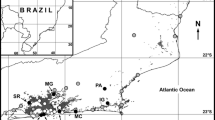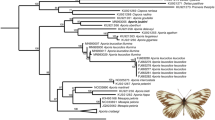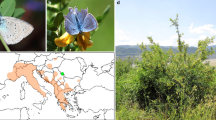Abstract
The Diana fritillary, Speyeria diana (Cramer 1777) (Lepidoptera: Nymphalidae), is a North American endemic butterfly that disappeared from low elevation sites throughout its range in the twentieth century. It now persists in two geographically isolated mountainous regions, with an 800 km disjunction. Using mitochondrial cytochrome oxidase II DNA sequences from museum and field-sampled specimens, we found greater mtDNA diversity and more widespread differentiation among eastern populations than western ones. In addition, using coalescent-based population divergence models we dated the earliest splitting of eastern and western populations at least 20,000 years ago, during the Last Glacial Maximum. Therefore, the recent range collapse across the center of the historical species distribution may have exacerbated an ancient genetic differentiation between eastern and western populations. Finally, the loss of lowland haplotypes and the relatively large variation among local populations suggests that dispersal is low and lowland populations did not move to higher elevations, perhaps in response to climate change but, rather, appear to have vanished. Our results highlight the value of incorporating genetic data from preserved specimens when investigating the phylogeographic history and conservation status of a threatened species.







Similar content being viewed by others
References
Avise JC (2000) Phylogeography: The History and Formation of Species. Harvard University Press, Cambridge
Broquet T, Angelone S, Jaquiery J, Joly P, Lena JP, Lengagne T, Plenet S, Luquet E, Perrin N (2010) Genetic bottlenecks driven by population disconnection. Conserv Biol 24:1596–1605
Brower AVZ (1994) Rapid morphological radiation and convergence among races of the butterfly Heliconius erato inferred from patterns of mitochondrial DNA evolution. Proc Natl Acad Sci USA 91:6491–6495
Campbell JW, Hanula JL, Waldrop TA (2007) Observations of Speyeria diana (Diana fritillary) utilizing forested areas in North Carolina that have been mechanically thinned and burned. Southeast Nat 6:179–182
Cech R, Tudor G (2005) Butterflies of the east coast. Princeton University Press, Princeton
Dupanloup I, Schneider S, Excoffier L (2002) A simulated annealing approach to define the genetic structure of populations. Mol Ecol 11:2571–2581
Ersts PJ (2013) [Internet] Geographic Distance Matrix Generator (version 1.2.3). American Museum of Natural History, Center for Biodiversity and Conservation. http://biodiversityinformatics.amnh.org/open_source/gdmg. Accessed 15 Oct 2013
Excoffier L, Lischer HEL (2010) Arlequin suite ver 3.5: a new series of programs to perform population genetics analyses under Linux and Windows. Mol Ecol Res 10:564–567
Frankham R, Ballou JD, Briscoe DA (2002) Introduction to conservation genetics. Cambridge University Press, Cambridge
Fu Y-X (1997) Statistical tests of neutrality of mutations against population growth, hitchhiking and background selection. Genetics 147:915–925
Gratton P, Konopinski MK, Sbordoni V (2008) Pleistocene evolutionary history of the Clouded Apollo (Parnassius mnemosyne): genetic signatures of climate cycles and a ‘time-dependent’ mitochondrial substitution rate. Mol Ecol 17:4248–4262
Haddad N (2000) Corridor length and patch colonization by a butterfly, Junonia coenia. Conserv Biol 14:738–745
Hajibabaei M, Smith M, Janzen DH, Rodriguez JJ, Whitfield JB, Hebert PD (2006) A minimalist barcode can identify a specimen whose DNA is degraded. Mol Ecol Notes 6:959–964
Hammond PC, McCorkle DV (1983) The decline and extinction of Speyeria populaions resulting from human environmental disturbances (Nymphaldae: Argynninae). J Res Lepid 22:217–224
Hey J (2010) Isolation with migration models for more than two populations. Mol Biol Evol 27:905–920
Hey J, Nielsen R (2007) Integration within the Felsenstein equation for improved Markov chain Monte Carlo methods in population genetics. Proc Natl Acad Sci USA 104:2785–2790
Huson DH, Bryant D (2006) Application of Phylogenetic Networks in Evolutionary Studies. Mol Biol Evol 23:254–267
Keyghobadi N, Koscinski D, Weintraub JD, Fonseca DM (2012) Historical specimens reveal past relationships and current conservation status of populations in a declining species: the regal fritillary butterfly. Insect Conserv Divers 6:234–242
Larkin MA, Blackshields G, Brown NP, Chenna R, McGettigan PA, McWilliam H, Valentin F, Wallace IM, Wilm A, Lopez R, Thompson JD, Gibson TJ, Higgins DG (2007) ClustalW and ClustalX version 2. Bioinformatics 23:2947–2948
Lowe WH, Allendorf W (2010) What can genetics tell us about population connectivity? Mol Ecol 19:3038–3051
Moran M, Baldridge C (2002) Distribution of the Diana fritillary, Speyeria diana (Nymphalidae) in Arkansas, with notes on nectar plant and habitat preference. J Lepid Soc 56:162–165
Münzbergová Z, Cousins SAO, Herben T, Plačková I, Mildén M, Ehrlén J (2013) Historical habitat connectivity affects current genetic structure in a grassland species. Plant Biol 15:195–202
Opler P, Krizek G (1984) Butterflies east of the Great Plains. Johns Hopkins University Press, Baltimore
Posada D (2006) ModelTest Server: a web-based tool for the statistical selection of models of nucleotide substitution online. Nucleic Acids Res 34:W700–W703
Rice WR (1989) Analyzing tables of statistical tests. Evolution 43:223–225
Rudolph DC, Ely AC, Schefer RR, Williamson JH, Thill RE (2006) The Diana fritillary (Speyeria diana) and Great Spangled fritillary (S. cybele): dependence on fire in the Ouachita Mountains of Arkansas. J Lepid Soc 60:218–226
Tajima F (1989) Statistical method for testing the neutral mutation hypothesis by DNA polymorphism. Genetics 125:585–593
Thill RE, Rudolph DC, Koerth NE (2004) Shortleaf pine-bluestem restoration for Red-cockaded woodpeckers in the Ouachita Mountains: Implications for other taxa. In: Costa R, Daniels SJ (eds) Red-cockaded Woodpecker: road to recovery. Hancock House Publishers, Blaine, pp 657–671
Wells CN, Smith EA (2013) Observations of resource use by the threatened Diana Fritillary butterfly (Speyeria diana) in the Southern Appalachian Mountains, USA. J Insects. doi:10.1155/2013/130694
Wells CN, Tonkyn DW (2014) Range collapse in the Diana fritillary, Speyeria diana (Nymphalidae). Insect Conserv Divers 7:365–380
Williams BE (2001a) Patterns of morphological variation in Speyeria idalia (Lepidoptera: Nymphalidae) with implications for taxonomy and conservation. Ann Entomol Soc Am 94:239–243
Williams BE (2001b) Recognition of western populations of Speyeria idalia (Nymphalidae) as a new subspecies. J Lepid Soc 55:144–149
Williams BE (2002) Conservation genetics, extinction, and taxonomic status: a case history of the regal fritillary. Conserv Biol 16:148–157
Williams BE, Brawn JD, Page KN (2003) Landscape scale genetic effects of habitat fragmentation on a high gene flow species: Speyeria idalia (Nymphalidae). Mol Ecol 12:11–20
Acknowledgments
This work was funded by the Clemson University Creative Inquiry Program, the Sarah Bradley Tyson Memorial Fellowship, the Blue Ridge Parkway Foundation, and a collection grant from the American Museum of Natural History. We appreciate guidance from Peter Adler, David Heckel, and the reviewers that improved this manuscript. We thank the museum curators who contributed to this project, including Bob Robbins (Smithsonian National Museum of Natural History), Blanca Huertas (British Natural History Museum), David Grimaldi (American Museum of Natural History), James Boone (Field Museum), John Rawlins (Carnegie Museum of Natural History), Tim Tomon (Carnegie Museum of Natural History), Behnaz van Bekkum-Ansari (Netherlands Centre for Biodiversity Naturalis Collection), Jacques Pierre (Paris Muséum national d’Histoire naturelle), and Willem Hogenes (Zoölogisch Museum Amsterdam). We also thank Chelsea Woodworth, Eric Smith, Jason Love, William Baltosser, Bill Garth, Tom Payne, Brent Kelley, Connie Wells, Sandy Emme, Sergio Marchant, and Holly Nance who assisted with field and lab work.
Author information
Authors and Affiliations
Corresponding author
Electronic supplementary material
Below is the link to the electronic supplementary material.
Rights and permissions
About this article
Cite this article
Wells, C.N., Marko, P.B. & Tonkyn, D.W. The phylogeographic history of the threatened Diana fritillary, Speyeria diana (Lepidoptera: Nymphalidae): with implications for conservation. Conserv Genet 16, 703–716 (2015). https://doi.org/10.1007/s10592-014-0694-9
Received:
Accepted:
Published:
Issue Date:
DOI: https://doi.org/10.1007/s10592-014-0694-9




